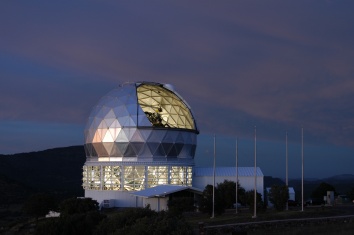Astronomers measure largest-ever magnetic field around massive star, time its slow rotation as it drags around giant cloak of trapped particles
11 September 2012
FORT DAVIS, Texas — A group of astronomers led by Gregg Wade of the Royal Military College of Canada have used the Hobby-Eberly Telescope (HET) at The University of Texas at Austin's McDonald Observatory and the Canada-France Hawaii Telescope (CFHT) on Hawaii's Mauna Kea to measure the most magnetic massive star yet. Their work is published in today's issue of the research journal Monthly Notices of the Royal Astronomical Society.
The star's magnetic field is 20,000 times stronger than the Sun's, and almost 10 times stronger than that detected around any other high-mass star. At about 35 times the Sun's mass, the O-type star NGC 1624-2 lies in the open star cluster NGC 1624, about 20,000 light-years away in the constellation Perseus.
This star is an extreme case study to help astronomers better understand all massive stars, which play an important role in the evolution of galaxies.
"Understanding the evolution of massive stars, those that explode as core-collapse supernovae, is really important," said team member Anne Pellerin of Canada's Mount Allison University. (Formerly a researcher at Texas A&M University, Pellerin used the Hobby-Eberly Telescope via an agreement between The University of Texas at Austin and Texas A&M.)
When the stars explode, the heavy chemical elements born in the cores are scattered into space, she explained. "In the big picture, the Sun is born from the debris of a supernova that exploded — that's how we get iron."
Additionally, despite their short lives (NGC 1624-2 will live only about five million years, or one-tenth of one percent of the Sun's current age at midlife), massive stars shape the galaxies in which they live. "Their strong winds, intense radiation fields, and dramatic supernova explosions make them the primary sculptors of the structure, chemistry, and evolution of galaxies," Wade said.
But "massive stars are rare," Pellerin said. "Anything we can do to get to know them is good." She explained that the extreme magnetic fields of massive stars aren't well understood.
"The most important consequence of the strong magnetic field is that it binds and controls the stellar wind of NGC 1624-2 to a very large distance from the star — 11.4 times the star's radius," Wade said. "The huge volume of this magnetosphere is remarkable. It's more than four times wider than that of any other comparable massive star, and in terms of volume it is around 80 times larger." The star's magnetic field also influences the internal structure of NGC 1624-2, he said.
Thus the magnetic field can strongly influence a massive star's life, from birth to supernova death. But because these magnetic fields are poorly understood, models of stellar evolution are incomplete.
"We need observations of stars like NGC 1624-2 to teach us what's really going on," Wade said.
The team wanted to better understand the nature of this monster star, but it is so distant, and surrounded by dust, that they needed a large telescope with immense light-gathering power to study its light in detail.
"This star is hard to observe because it's highly extinguished by dust," Pellerin said. "That makes it fainter, so it takes a bigger telescope mirror." They used the 9.2-meter HET coupled with its High Resolution Spectrograph instrument.
They teased out the star's rotation by studying repeating patterns in the star's spectrum from HET. The patterns in the spectra are caused by winds coming off of the star.
"The winds of massive stars are very dense, especially compared to the Sun's," which is called the solar wind, Pellerin said. "These stars are losing a lot of mass through their winds — up to 30 percent over their entire lives. The wind is a plasma, made up of charged particles that follow the lines of the magnetic field," she explained. "It creates some weird features in the spectra."
The repetition of such "weird features" in the star's light allowed the team to figure out that the star is rotating quite slowly: It takes this star about 160 Earth days to rotate once on its axis. (For comparison, it takes the Sun about 25 days to rotate on its axis.)
"We think that the star is slowed down because it has to drag its wind around — because the wind is bound to the magnetic field," Wade said. "This is something that has to be tested, but it looks very likely."
To measure the strength of star's magnetic field, the team used the Canada-France-Hawaii Telescope (CFHT) coupled with an instrument called ESPaDOnS. Specifically, they measured small biases in the direction of rotation of the electromagnetic waves absorbed or emitted by atoms located in the field.
"An excess of clockwise-rotating waves indicates a magnetic field pointing towards us, while an excess of counterclockwise-rotating waves indicates a magnetic field pointing away from us," Wade said. "The larger the excess, the larger the magnetic field. These excesses are usually very tiny, requiring many observations or careful processing of the data to tease out the signal. But in the case of NGC 1624-2, it was obvious from our very first observations that a remarkably strong magnetic field was present."
ESPaDOnS is the most powerful instrument in the world for this kind of work, Wade said.
Founded in 1932, The University of Texas at Austin's McDonald Observatory hosts a multiple telescopes undertaking a variety of astronomical research under the darkest night skies of any professional observatory in the continental United States. McDonald is home to one of the world's largest telescopes, the 9.2-meter Hobby-Eberly Telescope, a joint project of The University of Texas at Austin, Pennsylvania State University, Ludwig Maximilians Universität München, and Georg-August-Universität Göttingen. An international leader in astronomy education and outreach, McDonald Observatory is also pioneering the next generation of astronomical research as a partner in the Giant Magellan Telescope.
— END —
Science Contacts:
Dr. Gregg Wade, Royal Military College of Canada: 613-541-1300 (ext. 6140)
Dr. Anne Pellerin, Mount Allison University: 506-364-2582
Media Contacts:
Rebecca Johnson, Press Officer, McDonald Observatory, Univ. of Texas at Austin: 512-475-6763
Dr. Daniel Devost, Director of Science Operations, Canada-France-Hawaii Telescope Corporation: 808-885-3163
Captain Yvette Gregoryev, Public Affairs Officer, Royal Military College of Canada: 613-541-6000 (ext. 6484)







